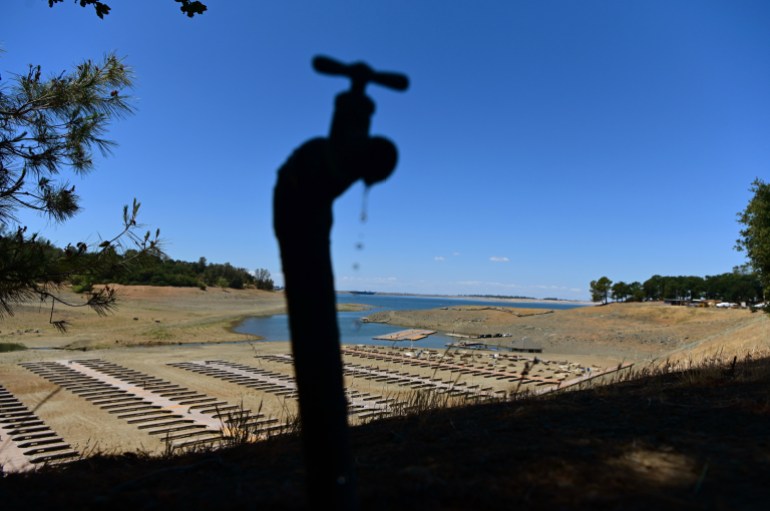Megadrought ‘taxing’ US water reservoirs and fuelling wildfires
Experts are pointing fingers at climate change, saying it is ‘a long-term tax on the water budget of the west’.

A decades-long climate change-fuelled drought in the western United States is drying reservoirs and contributing to an early wildfire season, scientists say.
Flames have scorched more than a million acres (more than 404,000 hectares) across the country so far this year. More than 28,000 fires have burned in 2021 — the highest number of fires at this time of year since 2011.
Keep reading
list of 3 itemsGlobal warming may have already passed irreversible tipping point
Grid operators in California and Texas brace for record heat
As people turn to air conditioners to survive heat waves, California and other states are warning people to conserve energy to avoid straining power grids.
According to the US Drought Monitor, states across the west are experiencing extreme and exceptional drought conditions. The conditions have been continuing for two decades, leading scientists to call it a “megadrought.”
“The southwestern US is in a protracted drought period, or megadrought, of the likes we haven’t seen in the observational record in the last millennia,” explained John Abatzoglou, an associate professor at the University of California researching climate and weather.

“In the west this year, there’s an astronomical fraction of land that is experiencing severe drought,” Abatzoglou said. This past winter and spring, lacklustre precipitation plus warm temperatures meant low snowpack in the mountains, resulting in rapid drying of the land surface, he said.
Wildfires threatening Arizona ranches
Arizona, which has its wildfire season in the spring, has the most fires and largest acreage burned of any state so far this year, according to the National Interagency Fire Center. Seven fires have burned 270,000 acres (109,265 hectares) across the state. Hot, dry conditions have led the Bureau of Land Management to issue fire restrictions.
Firefighters are working to contain the largest wildfire, the Telegraph Fire, in the Tonto National Forest and mountains east of Phoenix, where it has burned nearly 166,000 acres (67,178 hectares). It is now 72 percent contained but continues to threaten nearby communities.
Armando Rodriguez, a professional bull rider in the town of Winkelman, Arizona, told Al Jazeera he can see the smoke over the hilltops. Sheriffs have warned his community and others nearby to be in “ready mode.”

“Everyone’s more or less packing their stuff and getting ready for the green light if it does get to the point where they have to leave,” Rodriguez said over the phone Thursday.
If an evacuation is ordered, he plans to call on his neighbours to help him round up 500 cattle, load them onto trailers, and drive them to safety.
His family has run ranches in the area since the 1960s. “We’re not strangers to it,” he said of wildfires.
In April, flames burned through the nearby community of Dudleyville, incinerating at least 12 homes and forcing 200 people to flee, according to the Associated Press news agency.
“We’ve dealt with fires, floods, so it’s nothing new to us, but it seems like this year it’s been happening more frequently,” Rodriguez said.
Blaming climate change
It is not clear if climate change is directly to blame for lower precipitation across the west this year, but it is certainly to blame for larger factors that accelerate drought, Abatzoglou said.
Global heating is causing more precipitation to fall as rain instead of snow, which alters the water cycle (the movement of water from the ocean to the atmosphere to the earth and back again), he said. Our warming climate is also contributing to more drying and increased evaporation.
“The warming is basically acting as a long-term tax on the water budget of the west,” he explained.
Scientists expect another dangerous wildfire season in California.
Lack of precipitation and snowpack means plants across the state are dry, crispy and ready to burn, explained Craig Clements, director of the Wildfire Interdisciplinary Research Center at San Jose State University. This means the state will likely see an earlier wildfire season, with fires growing increasingly dangerous in the summer and fall, he said.
Clements said a combination of factors are leading to more intense wildfires in California: poor management has left forests packed with too many trees and brush. Wildfires are part of a natural cycle that allows life to flourish, but he explained, “we haven’t allowed fires into our ecosystems for a hundred years.”
Now, climate change is drying out that extra fuel, so there is abundant tinder ready to ignite and burn.
In Arizona, Rodriguez is hoping for rain, and praying that his community will be safe. “Shout out to all the firefighters and first responders that are helping out right now, may God be with them, and hopefully nobody gets hurt,” he said.
“As far as the fire goes, that’s a breathing beast, and it’s gonna burn what it’s gonna burn,” he added.